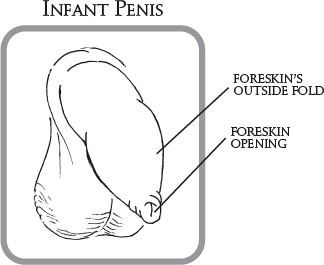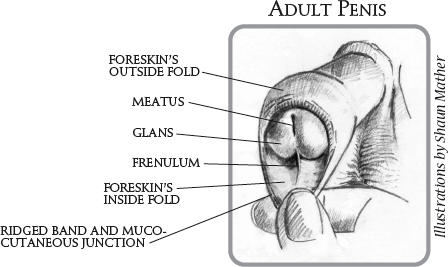
|

|
|
4 |
NOCIRC Information Series: Intact Penis |
National Organization of Circumcision Information Resource Centers
The foreskin - also known as the prepuce - is the fold of skin that normally covers and protects the glans of the penis.
The foreskin's inside fold is mucous membrane, like the inside of the mouth, and keeps the surface of the glans soft, moist and sensitive.
The foreskin contains a rich supply of blood vessels and a dense concentration of nerve endings.
The frenulum, the fold of tissue on the underside of the penis, secures the foreskin in its forward position.
Specialized erogenous tissue, named the ridged band, encircles the foreskin at its mucocutaneous junction (where the foreskin's inside and outside folds meet).

|

|
"What looks like a pin point opening at 7 months will become a wide channel of communication at 17."- Sir James Spence |
The intact penis needs no special care.
The foreskin should never be retracted by force.
During the first few years of a male's life, the inside fold of his foreskin is attached to his glans, very much the way the eyelids of a newborn kitten are sealed closed. The tissue that connects these two surfaces dissolves naturally over time - a process that should never be hurried.
The foreskin can be retracted when its inside fold separates from the glans and its opening widens. This usually happens by age 18. Even if the glans and foreskin separate by themselves in infancy, the foreskin may not be retractable then because the opening of a baby's foreskin may be just large enough to allow for the passage of urine.
The first person to retract a child's foreskin should be the child himself.
A very young boy usually pulls his foreskin outward. This is normal and natural and no cause for concern; he won't hurt himself. Once a boy discovers that his foreskin is retractable (a wondrous discovery for an intact child), he can easily learn to care for himself. Telling your son about retractability beforehand will keep him from becoming alarmed the first time his foreskin retracts.
When a boy is old enough to bathe himself, he can wash his penis when he washes the rest of himself. Simple instructions may be helpful.
|
At puberty, you can let your son know that with hormonal activity comes new responsibility, including genital hygiene.
Sometimes the tip of the foreskin becomes reddened. This indicates the foreskin is doing its job of protecting the glans and urinary meatus (the opening for the passage of urine and semen).
When bacteria in the feces react with urine, they produce ammonia that burns the skin and causes ammoniacal dermatitis, commonly known as diaper rash.
Other causes of a reddened foreskin are:
|
Drinking water, soaking in warm baths, and running around with bare bottoms help healing.
The white lump is made up of the cells that once attached his foreskin to his glans. As new cells form on the glans and the foreskin's inside fold, old cells form "pockets" that eventually work their way to the tip of the foreskin, where they can simply be wiped away. The space they occupied becomes the preputial space between the foreskin and the glans. So, if you see a white lump under your son's foreskin, you know that the separation of his foreskin and glans is occurring naturally.
"The worst foreskin problem most intact males ever have is that someone thinks they have a problem."- John A. Erickson |
What is phimosis?
The Greek word phimosis means muzzled and is used — often incorrectly — to refer to a foreskin that cannot be retracted (for whatever reason). A comprehensive discussion of phimosis is beyond the scope of this pamphlet. What parents should know is that almost all babies have a non-retractable foreskin. This is normal. The foreskin of most males becomes fully retractable by age 18. It is also important to know that many adult males with non-retractable foreskins are perfectly happy with them that way. Adult males with a non-retractable foreskin, who would rather their foreskin retract, can easily and safely stretch their foreskin opening until it is large enough to slip comfortably over their glans. A non-retractable foreskin is not, in itself, an indication for circumcision.
What happens if someone retracts my son's foreskin prematurely?
Forcing the foreskin back can be very painful and can cause problems.
Tearing the foreskin from the glans leaves raw, open wounds, which can lead to infection.
Raw surfaces on the foreskin and glans can heal together, forming adhesions.
Small tears in the opening of the foreskin can heal to form non-elastic scar tissue, possibly causing acquired phimosis.
The foreskin can get "stuck" behind the glans (paraphimosis). By squeezing the glans, the foreskin can be brought forward again, without circumcision.
Why does my son's foreskin "balloon" when he urinates?
This is another indication that the natural separation of his foreskin and glans is occurring. One elderly Irishman tells how, as a boy, he and his friends "lucky enough to have a foreskin that ballooned" would stand in a row, urinate, then squeeze the balloon to see who could "shoot" the farthest. As the preputial opening widens, most boys decrease their chances of winning the game but increase their ability to retract their foreskin.
Many doctors are unaware of the most recent information about the intact penis and recommend circumcision for any and every foreskin problem. The National Organization of Circumcision Information Resource Centers, which is dedicated to preserving and protecting children's normal, natural wholeness, will be happy to direct you to a doctor who understands the foreskin's functions and importance.
More information can be found at:
www.nocirc.org and www.cirp.org
NOCIRC pamphlets: Ten different pamphlets: 50¢ each or $25/100 (same or mixed) plus $5 S/H.
The NOCIRC Resource Guide lists the pamphlets, books, articles, newsletters, and videos available from NOCIRC, and other resources as well. Free for SASE.
National Organization of Circumcision
Information Resource Centers
Post Office Box 2512
San Anselmo, CA 94979-2512 USA
Telephone: 415-488-9883
Fax: 415-488-9660
www.nocirc.org
The information in this pamphlet is not intended to replace the advice and care of your pediatrician.
Back To: NOCIRC Publications Main Page.
1/04